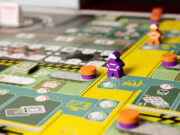 Most people have a coming of age story. A story where they made their own path and accomplished something on their own. For elves, as with humans, this same tradition occurs or at least that is what the game Elfenland wants you to accomplish. Elfenland is a hand management and route planning game where players attempt to prove their adult elfhood by visiting major cities in the fantasy world of Elfenland. Will this game stand up to this daunting task or be forced to live in their parents basements for years to come? This game was designed by Allen Moon, better known for Ticket to Ride and Airlines Europe, and won the Spiel Des Jahres (German Game of the Year), way back in 1998. The game takes about an hour to play and is best suited for 4 or more players.
Most people have a coming of age story. A story where they made their own path and accomplished something on their own. For elves, as with humans, this same tradition occurs or at least that is what the game Elfenland wants you to accomplish. Elfenland is a hand management and route planning game where players attempt to prove their adult elfhood by visiting major cities in the fantasy world of Elfenland. Will this game stand up to this daunting task or be forced to live in their parents basements for years to come? This game was designed by Allen Moon, better known for Ticket to Ride and Airlines Europe, and won the Spiel Des Jahres (German Game of the Year), way back in 1998. The game takes about an hour to play and is best suited for 4 or more players.
Game Overview:
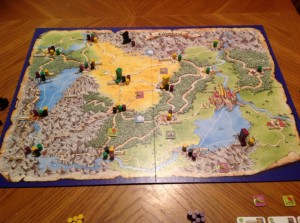
The game has a very strong fantasy theme as most of you could guess from the title. In the world of Elfenland, young elves must take a special test to move into adulthood. The players take the role of one of these young elfs, attempting to visit as many towns on the map as they can. Over 4 round of play, players will use travel cards to use the common modes of transportation used in this land, such as elfcycle, magic cloud and unicorns. The first time a player passes through a city they will get a token of their color and whoever has been to the most cities at the ends of the game wins.
Components:
The best thing about the components is the game board. For me, an admitted lover of maps, it’s one of the best maps I have seen. It’s not the flashiest map I’ve seen and shows some of its age after 15 years, but I find it has a lot of charm. Every section is distinct and worth taking your time to look at. Also, I like how they integrated the roads into the map. I helps to form a more seamless game experience. The only component gripe I have about the game is the choice of using cylinders as the town pieces in the game. If one ever gets knocked over, it will roll off the table and might never been seen again. It’s just annoying. This is one of the few times I wish that the game would just come with colored cubes. The rest of the components are fine, but have nothing amazing about them worth mentioning.
How to Play:
The game is fairly easy to learn. There are only six phases in each round and most of them take very little time to complete. A round plays out as follows:
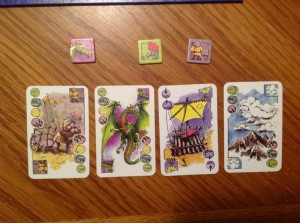
1. Deal the Travel Cards
Each player receives 8 travel cards. These cards will have all the different types of transportation available for the player this round. The transportation available in Elfenland; Giant Pig, Elfcycle, Magic Cloud, Unicorn, Troll Wagon, Dragon and Rafts, can be used in the different geographical regions, woods, plains, desert, mountains and water in the land. The trick is that some of these transportation options work better in certain regions than others. In some cases, using a certain type of transportation is too difficult and some you can’t use at all. But before you can travel around with these cards, you must decide what type of transport is going to be used on the roads between the cities.
2. Draw a face down transportation counter
These counters, 48 total, have all the different types of transport in Elfenland. Later, you will have to play these tiles on the roads between cities. After you place a tile, the rest of the players will get a turn before you can place another. If another player places a counter on a road, that is the only type of transportation that any player can use that round. If you wanted to use unicorns on a road and someone else plays a counter with a giant pig on it, you have to use giant pigs on that road for this round. The face down counter at this point helps players to be able to hide what they could play in the future from other players.
3. Draw Additional Transportation Counters
Players draw an additional 3 transportation counters to use in this round. They either choose from the 5 tiles that are face up or draw a random face down tile.
4. Plan the Travel Routes
Beginning with the starting player, the players take turns to place counters face up on the roads on the board, described in phase 2 above. The counters must have a mode of transport on them that can be used in that region. Players also have an obstacle tile that they can play once per game. If a road doesn’t have a counter on it at the end of this phase, it can not be used for the movement during this round.
5. Move the Elf Boots
At this phase, players will play transportation cards out of their hands and move their player piece, an elf boot, across the game board. This will continue until a player is unable to advance their piece any further.
6. Finish the Round
The board is then cleared of all the transportation counters and the starting player is moved one person to the left. After that, the next round begins.
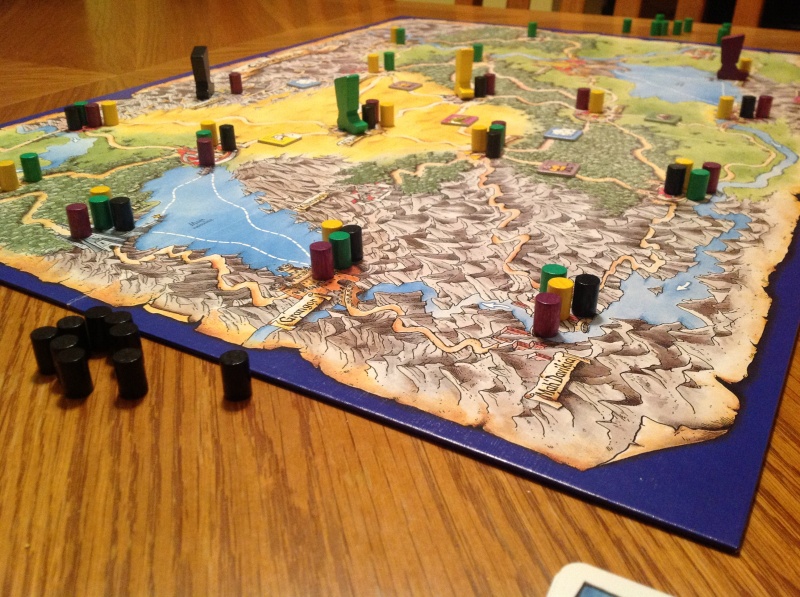
Game Experience:
When playing a game that has won the Spiel Des Jahres, the expectation is that you will play a game that is easily accessible and not difficult to learn. Elfenland does that. The simplicity of using the tiles to decide what type of transport can be used on roads that round add a ton of depth without adding a bunch of rules and complications to the game. When we played this game, players had a difficult time with some of the modes of transport in the game. I don’t know what they were thinking when they came up with the magic cloud, but with the weirdness of some of these makes the theme seem silly and doesn’t create a strong theme to game play connection. It makes sort of sense that a Elf would take a unicorn through the woods, I guess, but the theme isn’t want carries the enjoyment of the game.
The game isn’t that exciting until you get to the playing of the transportation counters. In each round that we played, someone played on a road that someone else wanted to use. They yelled at the person, with love, and then had to rethink their strategy all over again. This does slow the game down a bit and a lot if you have a few players in your group who are prone to ‘analysis paralysis’. I do think it’s a necessary part of the game to keep it interesting and force players to adjust to change. It’s fun to watch as someone else’s plan is ruined, but on occasion it takes way too long for a player to decide what they want to do once a plan is ruined. Besides this slow down, rounds move quickly and even if your plan gets messed up, you can recover easily in the next round. This unintentional ‘screw your neighbor’ aspect of the game keeps the game interesting and allows for a good amount of player interaction that won’t end in a ruined friendship.
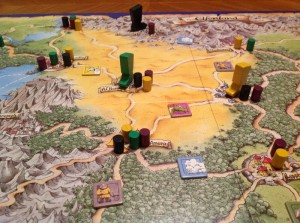
What makes this game great for me is the variety on what you can do on your turn. In most cities, you have 3 or more roads to travel on. This gives you the opportunity to cover as much ground as possible, regardless of what transportation cards and counters you have. The variety allows you to play this game numerous times and not take the same path around the land. Sometimes a game, after a few play throughs, will get stale and start to become repetitive. Elfenland doesn’t suffer from that.
A variation that is included with the game is that at the beginning of the game, players are giving a home city kept secret from other players. By the end of the game, a player needs to get back tot heir home city. If a player is unable to do this, they suffer a penalty of one city token for each road that they must travel to get back home. I feel that this should be used in all games after the first play through. This little addition adds more strategy and doesn’t slow the game down. A win in my book.
Final Thoughts:
In this game, I feel that Allen Moon starting the building blocks to design his most popular game Ticket to Ride. The theme falls short on being immersive, but doesn’t distract from the best part of the game, the variety and player interaction. Very rarely does a game have a nice blend of both of those aspects to allow you to feel that you are playing a new game every time. I also find it entertaining when someone throws you a curve ball and disrupts your well laid plans. It helps to add a bit of excitement to the game. Elfenland is accessible by gamers and non-gamers alike and is just fun to play. Elfenland is a game that might not be well known by many, but worth your time playing if you get the chance.
If you are interested in getting a copy for yourself, it’s about $25
Final Score: 3 Stars – A classic Spiel Des Jahres winner. With simple game play and great mechanics, this game will find its way to the table more than you expect.
 Hits:
Hits:
• Simple game play mechanics and good accessibility
• Endless variety of strategies to employ
• Awesome art work on the game board
Misses:
• Awkward city tokens
• Weak theme that can be distracting to some players
• Game can slow at times when player’s plans are ruined






